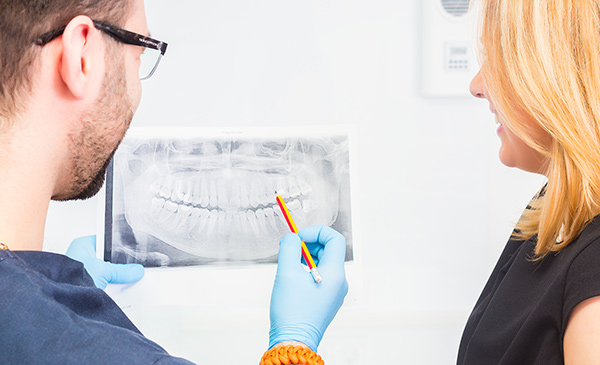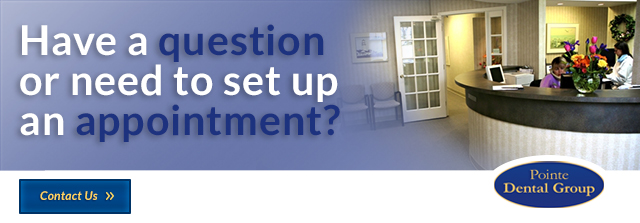
The concern regarding dental x-ray safety has grown in the recent years. With more public discussion surrounding the effects of radiation, we often have patients that ask us if they’ll be exposed during their routine dental cleaning visit. The truth is, all x-rays expose you to a low level of radiation. But how low is it, really? And is it necessary? Learn the facts about dental x-ray safety and the care we take to protect your health.
The Importance of Dental X-Rays
The only way for your dentist to see inside your teeth is with an x-ray. When you break a bone, it’s hard to hide. The same isn’t true for decay or damage to your teeth. Without x-rays, it can be difficult to identify problems between your teeth or buried at the roots of your mouth. Likewise, the health of your jaw is important and without x-rays, it wouldn’t be possible to easily identify potential injuries or warning signs.
Because of these unique challenges, dental x-rays are the only type of medical x-ray people typically receive on a regular basis. There are many types of x-rays that your dentist will use, each with their own function:
Bitewing – This very common type of dental x-ray is used to see the upper and lower posterior teeth. Your dentist can use the resulting image to identify decay and how your teeth contact each other.
Periapical – Used to find problems below the gum line, these x-rays image entire teeth from the exposed crown to the bones that support it.
Occlusal – If your dentist needs to look at the floor or roof of your mouth, they’ll take an occlusal x-ray. These can help find teeth that haven’t erupted yet or growths that might otherwise be invisible to the naked eye.
Panoramic – Panoramic x-rays offer a wider scope of imaging for your dentist to get a “full-picture view” of your mouth. The resulting image will show your jaws, teeth, sinuses, jaw joints and nasal area.
Dental X-Ray Radiation Levels
Radiation is measured in a unit called sieverts (Sv.) For most incidental exposures, it’s easier to measure them in microsieverts (µSv), as the radiation levels are so low. Your standard dental x-ray exposes you to approximately 5 µSv.
To understand dental x-ray safety, it’s best to compare its radiation exposure to other common sources. When looking at other medical x-rays, for instance, a full chest x-ray averages to about 100 µSv. But there are many other sources of radiation in your daily life.
Are you going on a vacation soon? A flight from New York to L.A. equals about 40 µSv. For frequent fliers, those miles high in the atmosphere add up. Another surprising fact is that bananas expose you to radiation – just .1 µSv – but they’re not the only food. In fact, the average person is exposed to about 400 µSv from their food each year. So, when you eat a normal diet, your body experiences about 80 dental x-rays worth of radiation per year.
While a dental x-ray does introduce more radiation into your body, when it’s compared to the other sources of daily radiation you receive, it’s easier to see that you shouldn’t be worried about them!
How Dentists Protect You
In radiation, there is a safety principle called “ALARA.” This stands for “as low as reasonably achievable.” Simply put, any medical professional that uses radiation in treatment or diagnosis will only expose you to the minimum amount required. They accomplish this in three ways: they minimize time, maximize distance, and use shielding.
For dental x-ray safety, you can probably identify two of these three principles easily. Your dentist minimizes exposure time by using quick, photographic x-rays that only briefly expose you to radiation. You also have likely worn the shielding apron that keeps your torso covered during the x-rays. The only issue is distance. Because dental x-rays are used to capture minute details of your mouth, your dentist must keep the machine close. Ultimately, this results in the small 5 µSv exposure, which is far less than most other medical x-rays.
Pregnancy & Dental X-Ray Safety
Many patients ask about the risks of radiation and pregnancy. According to the American College of Obstetricians and Gynecologists, x-rays are safe for pregnant women as long as proper protection is used. As long as your dentist uses shields for your abdomen and thyroid, there’s nothing to worry about!
Do You Need a Dental X-Ray? Schedule an Appointment Today!
Pointe Dental Group can provide you with a complete examination, answer your questions, and discuss your treatment options. Schedule an appointment with us today! New patients can receive FREE comprehensive exam and consultation, plus a full panoramic x-ray with a paid cleaning procedure (a $200 value)!
Grosse Pointe Farms: (313) 881-2480
Shelby Township: (586) 803-8300
Don’t miss a thing! Connect with us on Facebook!
